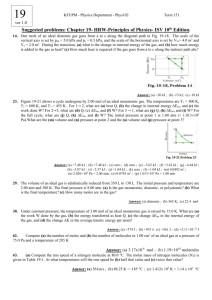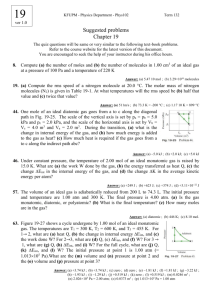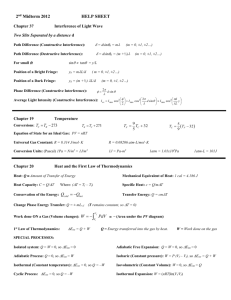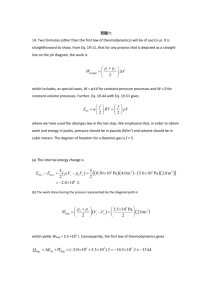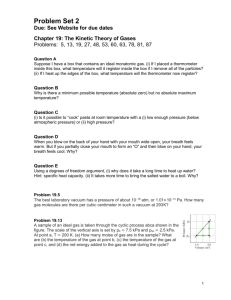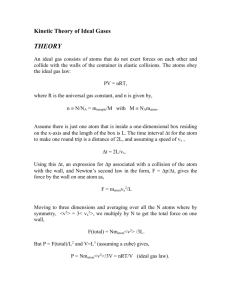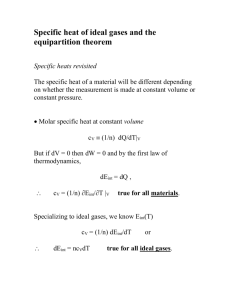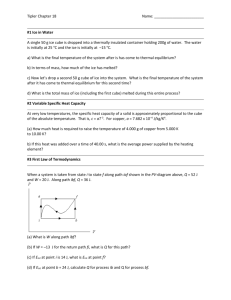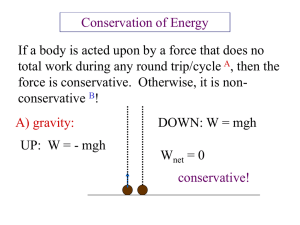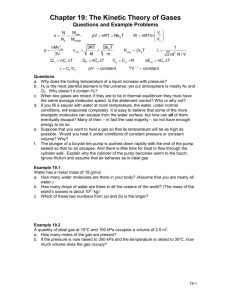國立中山大學98學年度普通物理(一)第三次段考 99
advertisement
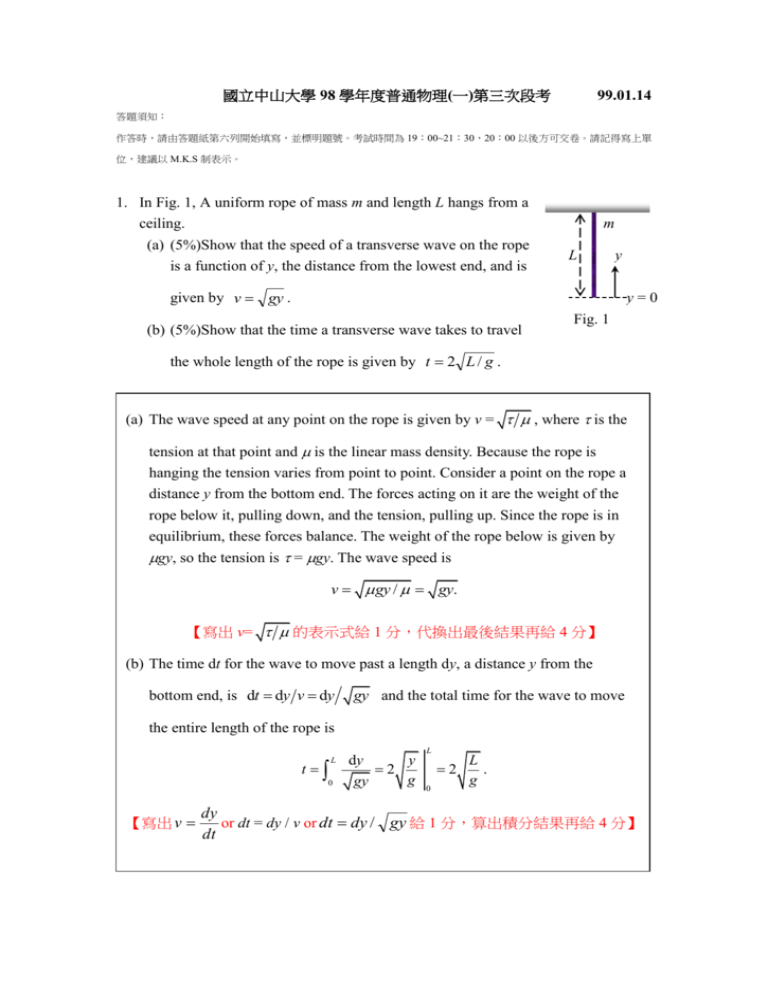
國立中山大學 98 學年度普通物理(一)第三次段考 99.01.14 答題須知: 作答時,請由答題紙第六列開始填寫,並標明題號。考試時間為 19:00~21:30,20:00 以後方可交卷。請記得寫上單 位,建議以 M.K.S 制表示。 1. In Fig. 1, A uniform rope of mass m and length L hangs from a ceiling. (a) (5%)Show that the speed of a transverse wave on the rope is a function of y, the distance from the lowest end, and is m L y given by v gy . y=0 (b) (5%)Show that the time a transverse wave takes to travel Fig. 1 the whole length of the rope is given by t 2 L / g . (a) The wave speed at any point on the rope is given by v = , where is the tension at that point and is the linear mass density. Because the rope is hanging the tension varies from point to point. Consider a point on the rope a distance y from the bottom end. The forces acting on it are the weight of the rope below it, pulling down, and the tension, pulling up. Since the rope is in equilibrium, these forces balance. The weight of the rope below is given by gy, so the tension is = gy. The wave speed is v gy / gy. 【寫出 v= 的表示式給 1 分,代換出最後結果再給 4 分】 (b) The time dt for the wave to move past a length dy, a distance y from the bottom end, is dt dy v dy gy and the total time for the wave to move the entire length of the rope is L t L 0 【寫出 v dy y 2 g gy 2 0 L . g dy or dt = dy / v or dt dy / gy 給 1 分,算出積分結果再給 4 分】 dt 2. A nylon guitar string has a linear density of 7.20 g/m and is under a tension of 150 N. The fixed supports are distance D = 90.0 cm apart. The string is oscillating in the standing wave pattern shown in Fig. 2. Calculate Fig. 2 (a) (4%)The speed of the wave (b) (3%)The wavelength (c) (3%)The frequency of the traveling waves whose superposition gives this standing wave (a) The speed of the wave is v 150N 7.20 103 kg / m 【列至此式給 2 分】 v = 144.34 m/s 1.44×102 m/s 【算出最後結果再給 2 分,無單位扣 1 分】 (b) From the figure, we find the wavelength of the standing wave to be = (2/3)(90.0 cm) = 60.0 cm. 【全對(含單位)才給分】 (c) The frequency is f v 1.44 102 m/s 241Hz. 0.600 m 【全對(含單位)才給分】 3. The intensity of a sound wave at a fixed distance from a speaker vibrating at 1.00 kHz is 0.600 W/m2. (a) (5%)What is the sound level of this wave in dB(聲音強度的基準為 I0 = 10-12 W/m2)? (b) (5%)Determine the intensity if the frequency is increased to a 2.50 kHz while a constant displacement amplitude is maintained. (a) 聲音強度的基準為 I o 1012 W/m 2 本題擴音器的聲音強度為 I 0.600 W/m 2 , 其強度級β為 I 0.6 10 log 12 10 log(6 1011 ) I0 10 10 log 【列至此式給 4 分】 10(log 6 11log10) 10(11 0.778) 117.75 dB 【算出最後結果(含單位)再給 1 分】 (b) 聲波強度之表示式為 I 1 2 v( S max ) 2 2 v 2 f 2 S max 2 聲波位移振輻 S max 為定值時, 【寫出 2 I f 2, I' f' ( )2 I f ∴ I' f' ( )2 給 4 分】 I f 2 f ' 2.5 103 I ' I 0.600 W / m 2 3 10 f = 2.52(0.600 W/m2) = 3.75 W/m2. 【註:聲波強度之符號可用 Smax , Ymax , 或 Amax 表示.】 【算出最後答案(含單位)再給 1 分】 4. A point source emits 30.0 W of sound isotropically(等向性地). A small microphone intercepts the sound in an area of 0.750 cm2, 200 m from the source. Calculate (a) (3%)the sound intensity there (b) (2%)the power intercepted by the microphone 波面 面積 A (a) r = 200 m 點波源的功率 P 30.0 W 點波源在均勻介質中產生球面波 P I 半徑為 200 m 的球面波波面面積為 A = 4r2 = 4(3.14)(200)2 = 5.024×105 m2 球面波上的強度為 I P 30.0 W 5.97 105 W / m 2 . 5 2 A 5.024 10 m 【全對(含單位)才給分】 波面 面積 A r = 200 m (b) 耳機的面積為 A = 0.75×10-4 m2 耳機接收到的聲波強度為 I 耳機 面積 A P = I A = (5.97×10-5 W/m2)(0.75×10-4 m2) = 4.48×10-9 W or 4.48 nW 【全對(含單位)才給分】 耳機 P 5. (5%)The maximum pressure amplitude Pm that the human ear can tolerate in loud sounds is about 28 Pa (1 Pa = 1 N/m2). What is the displacement amplitude Sm for such a sound in air of density = 1.21 kg/m2, at a frequency of 1000 Hz and a speed of 343 m/s? 聲波可用位移波與壓力波表示 位移波之波函數若為 S ( x, t ) Sm cos(kx t ) 則壓力波之波函數為 P( x, t ) Pm cos(kx t 2) Pm sin(kx t ) 上式中 P ( x, t ) 也可用 P( x, t ) 表示, Pm 也可用 Pm 表示 壓力波振幅 Pm 與位移波振幅的關係為 Pm k v 2 S m v S m 【寫出此式即給 4 分】 Sm Pm P Pm m 2 v v v (2 f ) 28 N/m2 (343 m/s)(1.21 kg/m3 )(2 )(1000 Hz) 1.1105 m 11 m 【算出最後結果(含單位)再給 1 分】 vA = 0 6. (a) (5%)In Fig. 3, Two whistles A and B, each vo = 30 m/s vB = 60 m/s have frequency of 680 Hz, A is stationary, and A O B B is moving toward right at velocity 60 m/sec, Fig. 3 an observer is between A and B, moving toward the right with velocity v0 = 30 m/sec. Take the velocity sound in air as 340 m/sec. What is the beat frequency heard by the observer? (b) (5%)A bat (蝙蝠) emits sound at frequency f = 38000 Hz, and fly directly toward a flat wall of a cave with velocity 1/20 times the speed of sound in air, what frequency does the bat hear reflected off the wall. vA = 0 A (a) O 聽到 A 之頻率: vo = 30 m/s O vB = 60 m/s B v v0 340 30 310 680 f A f 0 620 Hz 680 v v 340 0 340 s O 聽到 B 之頻率: v v0 340 30 370 340 30 680 f B f 0 629 Hz 【or f B 680 】 680 400 340 60 340 60 v vs ∴fb (拍頻率) = fB-fA = 629-620 = 9 Hz 【算出 fA 給 2 分,算出 fB 給 2 分,算出 fb 再給 1 分,最後答案無單位扣 1 分】 (b) 在 wall 接到 bat 之頻率 f1 f 0 vair = v v v0 v0 v f0 f0 【2 分】 v vs v v / 20 v v / 20 bat vb = v/20 bat 接到 wall 反射回來之頻率 f 2 f1 v v / 20 v v / 20 f1 【2 分】 v0 v v v v / 20 21 21 v v / 20 f0 38000 42000 Hz f0 v v v / 20 19 19 v v / 20 ∴ f2 f0 【算出 f1 給 2 分,算出 f2 給 2 分,算出最後答案(含單位)再給 1 分】 【利用投射方式直接列出 f 2 f 0 v v / 20 也可以】 v v / 20 f1 7. (a) (5%)A pipe with both end open, has length L. What is the resonant frequency of the third harmonic? (Assume the sound speed in air is v.) (b) (5%)In the case (a), if the pipe only one end open, find the resonant frequency of the first harmonic. (a) both end open (two open end) f v v nv 2L / n 2L for n = 3 f 3v . 2L 【答案對即給全分】 (b) one end open for n = 1 (first harmonic) L 1 v v ,∴ f 4 4L 【答案對即給全分】 8. (10%)A sample of an ideal gas goes through the process shown in Fig. 4. From A to B, the process is adiabatic; from B to C, it is isobaric with 100 kJ of energy entering the system by heat. From C to D, the process is isothermal; from D to A, it is isobaric with 150 kJ of energy leaving the system by heat. Determine the difference in internal energy Eint,B – Eint,A. * HALLIDAY 用書之定義 * Fig. 4 * SERWAY 用書之定義 * BC 過程 BC 過程 WBC = PB(VC-VB)=3 atm (0.400-0.0900) m3 = 94.2 kJ WBC = -PB(VC-VB)=-3 atm (0.400-0.0900) m3 = -94.2 kJ 【算出 BC 過程的功給 1 分】 【算出 BC 過程的功給 1 分】 Eint = Q-W Eint = Q+W Eint,C-Eint,B = (100-94.2) kJ = 5.79 kJ Eint,C-Eint,B = [100+(-94.2) kJ] = 5.79 kJ (內能也可以 U 表示) (內能也可以 U 表示) 【算出 BC 過程的內能變化給 2 分】 【算出 BC 過程的內能變化給 2 分】 CD 過程 CD 過程 Since T is constant, Since T is constant, Eint,D Eint,C 0 Eint,D Eint,C 0 【算出 CD 過程的內能變化給 2 分】 【算出 CD 過程的內能變化給 2 分】 DA 過程 DA 過程 WDA = PD(VA-VD) = 1 atm (0.200-1.20) m = -101 kJ WDA = -PD(VA-VD)=-1.00 atm (0.200-1.20) m3 = 101 kJ 【算出 DA 過程的功給 1 分】 【算出 DA 過程的功給 1 分】 Eint = Q-W Eint = Q+W Eint,A-Eint,D = [-150-(-101)] kJ = -48.7 kJ Eint,A-Eint,D = (-150 + 101) kJ = -48.7 kJ 3 (內能也可以 U 表示) (內能也可以 U 表示) 【算出 DA 過程的內能變化給 2 分】 【算出 DA 過程的內能變化給 2 分】 Now, Now, Eint,B-Eint,A = -[(Eint,C-Eint,B)+(Eint,D-Eint,C)+(Eint,A-Eint,D)] Eint,B-Eint,A = -[(Eint,C-Eint,B)+(Eint,D-Eint,C)+(Eint,A-Eint,D)] Eint,B-Eint,A = -[5.79 kJ+0-48.7 kJ] = Eint,B-Eint,A = -[5.79 kJ+0-48.7 kJ] = 42.9 kJ 【算出 AB 過程的內能變化(含單位)給 2 分】 42.9 kJ 【算出 AB 過程的內能變化(含單位)給 2 分】 【直接利用 W PdV 算出 AB 過程的功,再代入熱力學第一定律解內能變化也可以】 9. (10%)A solar energy collector (solar cooker) consists of a curved reflecting surface that concentrates sunlight onto the object to be warmed. The solar power per unit area reaching the Earth’s surface at the location is 600 W/m2. The cooker faces the Sun and has a diameter of 0.600 m. Assume that 40.0% of the incident energy is transferred to 0.500 kg of water in an open container, initially at 20.0C. How long does it take to completely boil away the water? (Ignore the heat capacity of the container.) (The specific heat of water: 4186 J/kg℃) (The latent heat of vaporization of water: 2.26×106 J/kg) The power incident on the solar collector is 2 Pi IA 600 W m 2 0.300 m 170 W 【算出到達 collector 的功率給 2 分】 . The total energy required to increase the temperature of the water to the boiling point and to evaporate it is Q cm T m LV : 【列出 20℃的水完全沸騰所需熱量之式子給 2 分】 Q 0.500 kg 4186 J kg C 80.0C 2.26 106 J kg 1.30 106 J 【算出熱量值給 2 分】 For a 40.0% reflector, the collected power is Pc 67.9 W The time interval required is t Q 1.30 106 J 5.31 h Pc 67.9 W 【列出t = Q/Pc 給 2 分,算出最後答案(含單位)再給 2 分】 10. (4%)An ideal gas expands at a constant temperature T from an initial volume Vi to a final volume Vf. Derive how much work done during the expansion? * HALLIDAY 用書之定義 * * SERWAY 用書之定義 * (i )W V pdV (i )W V pdV nRT 代入 V V nRT V (iii)W V dV nRT [ln V ]V V V ( IV )W nRT ln f Vi (ii)將p Vf Vf i i (ii)將p f i 【每一個步驟 1 分】 f i nRT 代入 V V nRT V (iii)W V dV nRT [ln V ]V V V ( IV )W nRT ln f Vi f i f i 【每一個步驟 1 分】 11. (3%)The molar mass of nitrogen molecules (N2) is 0.028 kg/mol. Compute the rms speed of a nitrogen molecule at 20.0°C. (The ideal gas constant R:8.31 J/molK) vrms 3RT 3(8.31J / mol K )(273 20) K 510.75m / s M 0.028kg / mol 【寫出公式即給 1 分,算出最後結果(含單位)再給 2 分】 12. The temperature of 2.00 mol of an ideal monatomic gas is raised from 300.0 K to 315.0 K at constant volume. (a) (3%)What is the average kinetic energy per atom of the initial state at 300 K? (b) (3%)What is the work W? (c) (3%)What is the energy transferred as heat Q? (d) (2%)What is the change Eint in the internal energy of the gas? (e) (2%)If the temperature of 2.00 mol of an ideal monatomic gas is raised 15.0 K at constant pressure, what is the work W during the process? (The ideal gas constant R:8.31 J/molK;Avogadro’s number NA:6.02×1023 mol-1) 3 3 kT (1.38 1023 J / K )(300K ) 6.21 1021 J 2 2 (a) Eavg (b)W V pdV p(V f Vi ) 0 Vf i 3 3 (c)Q nCv T (or nRT ) (2mol )( )(8.31J / mol K )(15K ) 373.95J 2 2 3 3 (d )E int nRT (or nCv T ) (2mol ) (8.31J / mol K )(15K ) 373.95J 2 2 (e) W Vf pdV pV nRT (2mol )(8.31J / mol K )(15K ) 249.3J Vi or W V pdV pV nRT (2mol )(8.31J / mol K )(15K ) 249.3J Vf i 【寫出公式即給 1 分,算出最後結果(含單位)再給全分】
